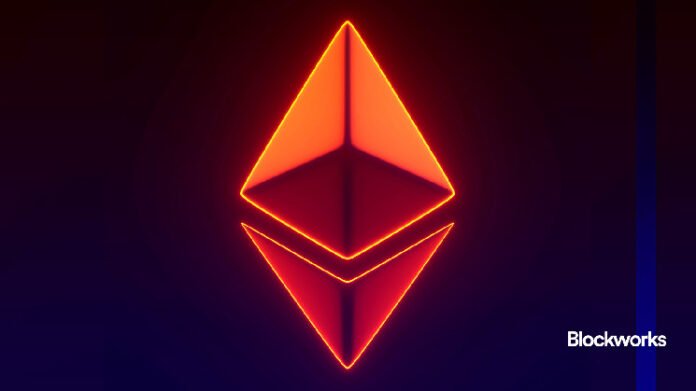Layer-2 sequencers have turn into dangerously centralized, introducing important dangers that undermine the foundational ideas of blockchain. To safeguard community integrity and stop the erosion of belief, we should urgently transition to a mannequin that does a greater job at eliminating single factors of failure.
Failing to take action jeopardizes community safety and exposes complete ecosystems to severe threats together with transaction censorship, safety breaches and the potential compromise of buyer information and funds.
Since Q2 2024, layer-2 options constructed atop the Ethereum community have been processing a median of 12x extra transactions than the bottom layer. Equally, on June 6, the full worth locked (TVL) of the layer-2 ecosystem rose to an all-time excessive of $49 billion, signaling the rising adoption of those “execution” networks. Nevertheless, as these options gained traction, an pressing subject has surfaced: the centralization of their sequencer operations.
Sequencers are important community elements liable for ordering and batching transactions earlier than they attain the Ethereum mainnet. Nevertheless, they’ve turn into a double-edged sword, providing effectivity at the price of decentralization.
Learn extra from our opinion part: Web3’s greatest safety menace is a well-known monster — centralization
Sequencers handle information stream in Ethereum’s layer-2 options by figuring out transaction order when a number of transactions happen concurrently. When two customers try and course of a transaction on the similar time, the sequencer decides who goes first.
Nevertheless, many of those instruments carry the potential dangers related to a single entity having management. Whereas centralized elements can allow quicker transaction processing, in addition they include important drawbacks, similar to the chance of censorship.
Such considerations usually are not unfounded. As we speak’s main layer-2s all depend on “centralized” sequencers, which typically means the corporate that constructed the rollup takes care of its sequencing operations all by itself.
For example, information exhibits that in March alone, Coinbase’s Base community generated $30 million in top-line income for the agency, simply primarily based on the sequencer charges — a determine that annualizes to roughly $360 million per 12 months.
Subsequently, in a quickly decentralizing panorama the place belief is supposed to be minimized, the notion of a single firm controlling a vital factor of a blockchain’s operation naturally raises eyebrows.
Christine Kim, vp of analysis at Galaxy Digital, contends that decentralization shouldn’t be seen as a binary state however slightly a spectrum, with centralized affect stored at a naked minimal. She has emphasised:
“A decentralized sequencer could also be one of many hardest initiatives for a rollup to work in direction of…to enhance its decentralization and resiliency […]”
With reference to minimizing centralized reliance, customers of Consensys-backed zkEVM rollup Linea just lately suffered losses amounting to $2.6 million. Nevertheless, what was most stunning in regards to the incident was the venture dev group’s unanimous choice to pause the sequencer and “censor attacker addresses to guard the customers and builders.”
This incident highlights the vital significance of decentralization and the hazards of centralization of the sequencer. By eradicating single factors of failure, decentralized sequencers make networks extra resilient to assaults and technical failures. Furthermore, they higher mirror the core values of blockchain know-how, particularly when it comes to transparency and effectivity.
On this regard, most layer-2 options are rapidly recognizing the advantages of distributing management. By leveraging a community of validators and block producers, layer-2 options can randomly choose and rotate sequencer nodes. These events share the duty of transaction ordering and batch submission, enhancing the community’s safety and resilience.
This technique ensures a good and safe sequencing course of whereas sustaining excessive efficiency, considerably decreasing the chance of censorship or manipulation. That in flip encourages group participation and aligns incentives between the community and its customers, thus adhering extra intently to the core ideas of blockchain know-how.
Not too long ago, Vitalik Buterin proposed a classification system for rollup networks — starting from stage 0 to stage 2 — expressing his perception that almost all main rollups at present depend on some type of “coaching wheels.”
Learn extra from our opinion part: Ethereum is ‘way more centralized than people understand’: Blocknative’s Matt Cutler
Transferring ahead, layer-2s should shed these provisional measures or threat stagnation. Whereas centralization undeniably gives profitable advantages and operational ease, it primarily serves the operator’s pursuits. Decentralization, although difficult, ushers in long-term benefits for each initiatives and their communities.
This “self-reinforcing mannequin” reduces safety prices and initiates a optimistic cycle. Greater group participation results in elevated staking and enhanced safety, attracting extra dapps and innovators.
Furthermore, the regular liquidity inflows to DEXs post-sequencer decentralization show that customers can settle for slight latency will increase when correctly incentivized. Past enhancing safety via mechanisms like liquid staking, sequencer decentralization aligns with worth distribution to business members and contributors.
Income sharing fashions like sequencer mining enhance person retention, making a direct correlation between group participation, community safety and ecosystem development. With technical primitives and purposeful examples available, even Bitcoin layer-2s are making ready to supply mining rewards via decentralized sequencers.
Going ahead, it’s merely not sufficient for the Ethereum layer-2 ecosystem to depend on only one community to have decentralized sequencers. Making the transition throughout a number of networks is paramount to safeguarding the integrity of blockchain know-how. Established layer-2s ought to act swiftly to keep away from obsolescence and make sure the security of their customers.
